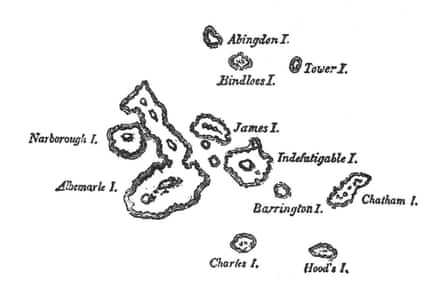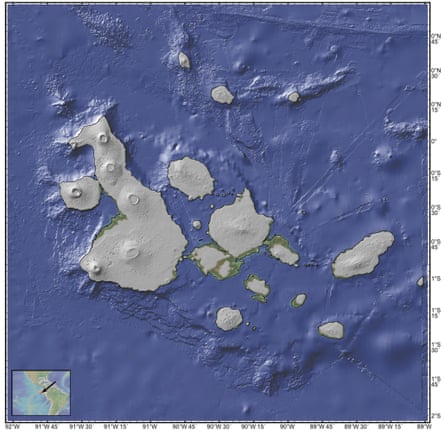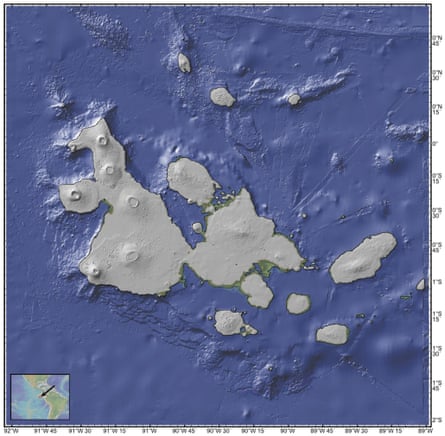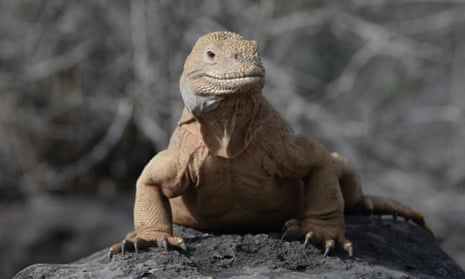When I think of the Galapagos, I see a map in my mind. It comes from Charles Darwin’s Journal of Researches, a simple engraving of a dozen or so major islands.

These volcanic belchings, which have bubbled up from beneath the underlying Nazca Plate, are gradually moving to the east, eroding and contracting as they do so until they disappear beneath the waves to join the submarine Carnegie Ridge. But new research reveals how changes in sea level may complicate this conventional wisdom.
It should come as no surprise that the sea level is in a state of constant flux. Indeed, it’s thought that over the course of the past 700,000 years, the sea level has undergone a significant drop every 100,000 years or so, falling to between 90 and 130m below the present level and staying that way for several thousand years. These events are likely to have had a major influence on the evolution of the creatures of Galapagos, say researchers.
“Recent shifts in sea level, particularly the lows, modified dramatically the geography of the Galapagos, and this may in turn have had important consequences for the biology,” write Jason Ali and Jonathan Aitchison in the Journal of Biogeography.
Considering several factors that are likely to have influenced sea level, they estimate that at the most recent low-point (around 20,000 years ago), the sea would have been 144m below its current level. Because the waters are relatively shallow in the centre of the archipelago, the island we now call Santa Cruz would have been much, much larger and completely enveloped smaller islands like Baltra and Santa Fe. I wonder if I could have walked from Isabela in the east (the large seahorse-shaped island) to the central island of Santa Cruz. With sea level at -150m, this would have been possible, says Ali. At -145m, “if you couldn't exactly walk between all of the 'core' islands, you could just about skip or jump between them,” he says.

Stepping back even further in geological time, the low points are predicted to have been progressively more extreme. At around 630,000 years ago, for instance, the authors estimate that the sea would have been 210m below its current level, leaving a central blob of land with just a few isolated outliers.

If Charles Darwin had happened to pitch up then, he certainly would not have found the islands “about 50 or 60 miles apart”. He might not have found them so “differently tenanted” either. The radical alterations to archipelago’s geography caused by this cyclical coalescence and isolation of islands is likely to have complicated the evolutionary history of several iconic Galapagos species, notably the land iguanas, lava lizards, leaf-toed geckos and racer snakes.
The snakes are particularly interesting, with the core islands in the archipelago occupied by two distinct species. The authors envisage the common ancestor of these two lineages slithering its way over the core platform when sea levels were low around 138,000 years ago. The subsequent rise in the oceans created two isolated populations that evolved into Pseudalsophis slevini to the west and P. dorsalis to the east. At the next low-point, 20,000 years ago, the two species came into contact once more. When the sea started to rise again, this may have provided the isolation necessary for another round of divergence (with scientists recognizing two closely related subspecies of P. slevini and three subspecies of P. dorsalis).
I am sorry that this new research comes too late to appear in my recent book The Galapagos. Not only is it fascinating in its own right, but there’s also a rather poetic historical aside that I would like to have included. Ali and Aitchison's paper brings to mind the idea of “land bridges” put forward the likes of vertebrate paleontologist George Baur and others in the 19th century. A physical connection (long-since subsided) had to have existed between mainland South America and the Galapagos, they argued, in order to account for presence of land-dwelling creatures like giant tortoises in the islands.
Charles Darwin did a lot to weather away this idea by opening our eyes to the distances and obstacles across which seeds, spiders, snails and even larger creatures might travel and by the 20th century the idea of land bridges (at least in relation to the Galapagos) had largely fallen out of favour. Interestingly, however, there was a notable figure who continued to argue for their existence well into the 20th century. For California Academy of Sciences herpetologist John Van Denburgh, land bridges were needed to account for the distributions of geckos and lava lizards and explain why several of the central islands have a similar suite of reptilain fauna. There might not have been a land bridge between the continent and the Galapagos, but it looks like they have played a part in the shaping some of the species Van Denburgh lived for.
This research is going to be of serious interest to Galapagos enthusiasts. “That such a seemingly well studied archipelago can still be presenting us with new and surprising findings is a perfect example of just how extraordinary the Galapagos Islands are,” says Ian Dunn, executive director of the Galapagos Conservation Trust.
It could also pave the way to apply similar logic to other low-lying clusters of islands. Where will Ali and Aitchison take their research next? The Cape Verde Islands, the Canaries or the Maldives, perhaps...

Comments (…)
Sign in or create your Guardian account to join the discussion